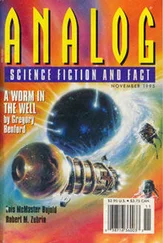Suddenly, it occurred to him that this was really happening. He grabbed her by the shoulders, crushed her to him. “Tamra! My Queen!” And he was crying, too, and laughing, and trying to tell her so many things at once that no words came out at all. They stood like that for a long time.
“Strange,” he mused later, as they rocked back and forth with her brown hair tickling his nose. “I’m the King, and you’re the Queen, and here we’ve never even been married.”
“I accept,” she murmured, then giggled a little and kissed him lightly on the neck.
And the rest, as they say, is history.
Appendix A
in which an appendix is provided
Perhaps it was novel, to imagine black holes not as highly compressed stars but as very heavy elementary particles— mega-particles, like protons massing a billion tons, their surfaces able to devour light, to bend time and space, to tear energies loose from the zero-point field of the “empty” vacuum itself…
An enterprise worth pursuing!
Einstein may have changed the world with his famous equation linking mass and energy, but when you ask the more fundamental question—just what is mass?—you soon find yourself scribbling:
E = mc 2
m = E/c 2
E/c 2= E/c 2
E = E
Mass is like energy because energy is like itself, just an electromagnetic vibration of the zero-point vacuum. Soon the quantum-age profusion of particles and forces falls away like a bad dream, leaving only charge, electromagnetism, and the vacuum. There is nothing else, no other force or substance required to construct the universe. And you wonder why you ever thought there was.
It all comes down to zitterbewegung vibrations—the “trembling motion” of charged particles buffeted by the very real energies of the zero-point field. Even the neutron is composed of quarks, charged + 2/ 3, – 1/ 3, and – 1/ 2proton equivalents, and the secondary fields emitted by these trembling particles give rise to a net force that is always attractive, always infinite in range, always difficult to block or channel or deflect. Call it gravity—Newton did. The experiment had been performed dozens of times before Bruno de Towaji came along: isolate a proton, subject it to oscillating electric fields at frequencies comparable to those of gravitation, and measure the increase in its mass. The Haisch effect. Bruno’s “genius” was simply to dump in a neuble’s worth of mass-energy, upping the frequency and amplitude of the oscillation, upping the illusory mass until the neuble was gone and the proton weighed a billion tons—enough to collapse it into a miniature black hole.
The rest had seemed obvious enough: two black holes, not only vibrating but vibrating each other , their interactions exactly 180 degrees out of phase with their zitterbewegung motions, gravities therefore canceling out. That turned out to be statically rather than dynamically stable, but eight holes arranged in a cube just so , at excruciatingly precise distances, would hold their positions indefinitely, for billions of years, for as long as the Hawking-bled holes themselves would last. A stiff cage, a “collapson,” the elementary building block of a wholly new material: crystalline collapsium.
Obvious.
And once you did this, once you began bricking the collapsons together into three-dimensional structures, you were well on your way to the control of physical reality at its most fundamental levels.
Consider the humble semiconductor, which is an insulating substance that can nonetheless conduct electrons within a certain range or “band” of energies. The most common of these is silicon, whose native oxide is the main crustal component of every terrestrial moon and planet. Silicon’s electrical properties are fixed by immutable physics, but through “doping,” the carefully controlled introduction of impurities, its crystals can be tuned so that, for example, room-temperature electrons have a good chance of jumping up into the conduction band when a voltage is applied.
Now, by layering these doped silica in particular ways, we can trap conduction electrons in a membrane so thin that from one face to the other, their behavior as tiny quantum wave packets takes precedence over their behavior as particles. This is called a “quantum well.” From there, confining the electrons along a second dimension produces a “quantum wire,” and finally, with three dimensions, a “quantum dot.”
The important thing about a quantum dot is that if it’s the right size, the electrons trapped in it will arrange themselves as though they were part of an atom, even though there’s no atomic nucleus for them to surround. Which atom they emulate depends on the number of electrons and the exact geometry of the wells confining them, and in fact where a normal atom is spherical, such “designer atoms” can be fashioned into cubes or tetrahedrons or any other shape, and filled not only with electrons but with positrons, muons, tau leptons, and other exotica to produce “atoms” with properties that simply don’t occur in nature.
Lastly, the quantum dots needn’t reside within the physical structure of our semiconductor; they can be maintained just above it through a careful balancing of electrical charges. In fact, this is the preferred method, since it permits the dots’ characteristics to be adjusted without any physical modification of the substrate.
So picture this: a diffuse lattice of crystalline silicon, superfine threads much thinner than a human hair crisscrossing to form a translucent structure with roughly the density of balsa wood, a structure which, like balsa wood, is mostly empty space. Except that with the application of electrical currents, that space can be filled with “atoms” of any desired species, producing a virtual substance with the mass of diffuse silicon, but the chemical, physical, and electrical properties of some new, hybrid material.
Being half composed of silicon, wellstone iron is less strong than its natural cousin, less conductive and ferromagnetic, basically less ironlike, and if you bash it over and over with a golf club it will gradually lose any resemblance, reverting to shattered silicon and empty space. On the other hand, it’s feather-light, wholly rustproof, and changeable at the flick of a bit into zinc, rubidium, or even imaginary substances like unobtanium, impossibilium, and rainbow kryptonite.
Well, half-kryptonite anyway; the rest is still silicon. However, since the theoretical properties of the “pure” substance will never occur outside a quantum well, the distinction is largely moot. The copyrighted element Bunkerlite, for example, is a million times stronger than the wellstone matrix that supports it. Together, they’re merely half a million times stronger.
Wellstone can also form compounds, amalgams, admixtures, sinters, and even whole solid-state devices; a thin square of it can be a hypercomputer if you like, or a clear glass window, or a stunningly accurate painting of your sister.
So it’s handy stuff to have around, particularly in conjunction with nanoassemblers and other semiadvanced technologies of the third millennium. The thing you need to remember is that by Bruno de Towaji’s time it was also dirt-common, its infinite potential mainly in the hands of bored or inept programmers who’d rather be looking at counterfeit naked pictures of the Queen.
A neuble-mass black hole—precisely the size of a proton— can absorb exactly two excess electrons before electrostatic repulsion overcomes gravitational attraction. By that time the hole’s mass—and therefore its Schwarzchild radius—has become 9.IE —31 percent larger. This infinitesimal widening is sufficient that the hole can consume an unlucky proton that strikes it just right—a statistical rarity but, given prolonged contact, an eventual certainty.
Читать дальше












